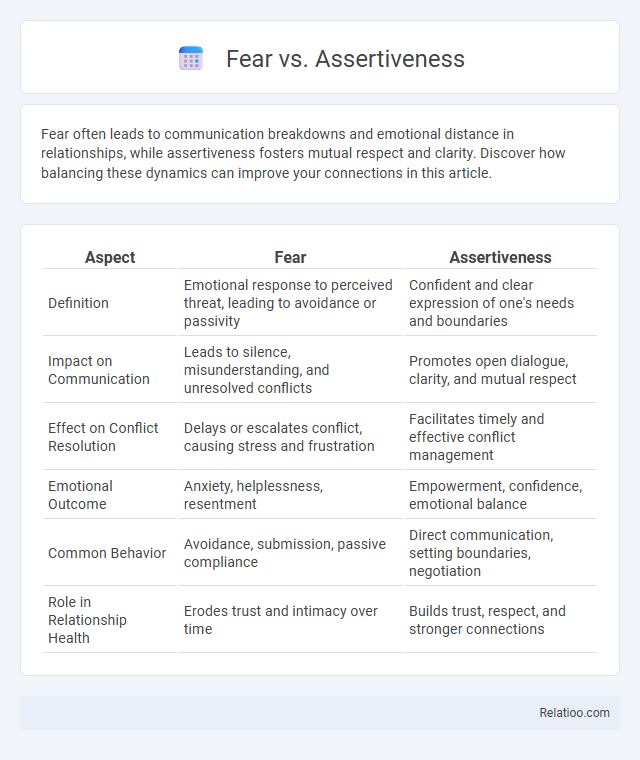Fear often leads to communication breakdowns and emotional distance in relationships, while assertiveness fosters mutual respect and clarity. Discover how balancing these dynamics can improve your connections in this article.
Table of Comparison
| Aspect | Fear | Assertiveness |
|---|---|---|
| Definition | Emotional response to perceived threat, leading to avoidance or passivity | Confident and clear expression of one's needs and boundaries |
| Impact on Communication | Leads to silence, misunderstanding, and unresolved conflicts | Promotes open dialogue, clarity, and mutual respect |
| Effect on Conflict Resolution | Delays or escalates conflict, causing stress and frustration | Facilitates timely and effective conflict management |
| Emotional Outcome | Anxiety, helplessness, resentment | Empowerment, confidence, emotional balance |
| Common Behavior | Avoidance, submission, passive compliance | Direct communication, setting boundaries, negotiation |
| Role in Relationship Health | Erodes trust and intimacy over time | Builds trust, respect, and stronger connections |
Understanding Fear: Definition and Origins
Fear is an emotional response to perceived threats that triggers your body's survival mechanisms through the amygdala and sympathetic nervous system. It originates from both innate evolutionary instincts and learned experiences, shaping how you react to danger or uncertainty. Understanding these neural and psychological roots helps differentiate fear from assertiveness, which involves confident self-expression without the paralyzing effects of fear.
Defining Assertiveness: Key Traits and Benefits
Assertiveness is the ability to express your thoughts, feelings, and needs confidently and respectfully without infringing on others' rights. Key traits include clear communication, emotional regulation, and self-confidence, which empower you to set boundaries and advocate for yourself effectively. Benefits of assertiveness encompass improved relationships, reduced stress, and enhanced decision-making skills.
How Fear Manifests in Everyday Life
Fear manifests in everyday life through physical symptoms such as increased heart rate, sweating, and muscle tension, often triggered by perceived threats or uncertainties. It can lead to avoidance behaviors, limiting your ability to take risks and express yourself confidently. Understanding the difference between fear and assertiveness empowers you to face challenges head-on, transforming anxiety into proactive communication and decision-making.
The Psychology Behind Assertiveness
Assertiveness is rooted in psychological self-awareness and emotional regulation, allowing individuals to express their thoughts and feelings confidently without infringing on others' rights. Unlike fear, which often triggers avoidance or passive behavior due to perceived threats or insecurity, assertiveness embodies a balanced state of mind that promotes clear communication and boundary-setting. Studies in social psychology highlight that assertiveness enhances interpersonal relationships and reduces anxiety by fostering mutual respect and self-efficacy.
Impact of Fear on Personal Growth
Fear often limits your potential by creating psychological barriers that hinder personal growth and self-improvement. Assertiveness, in contrast, empowers you to confront challenges confidently, enabling progress and resilience in the face of obstacles. Understanding the impact of fear on mindset and behavior is crucial for developing strategies that transform fear into motivation for personal development.
Assertiveness as a Tool for Effective Communication
Assertiveness empowers you to express thoughts and needs confidently while respecting others' boundaries, enhancing communication effectiveness. Unlike fear, which triggers hesitation or avoidance, assertiveness promotes clarity and mutual understanding in conversations. Mastering assertiveness as a communication tool improves relationships and fosters a positive environment for dialogue.
Common Misconceptions About Assertiveness
Common misconceptions about assertiveness include the belief that it is synonymous with aggression or being domineering, whereas true assertiveness involves expressing thoughts and feelings respectfully and confidently. People often confuse assertiveness with passivity or submission, failing to recognize that assertive behavior promotes clear communication and boundary-setting without fear. Understanding that assertiveness balances confidence with empathy helps dispel fears of social rejection and encourages healthier interpersonal dynamics.
Overcoming Fear: Practical Strategies
Overcoming fear requires developing assertiveness through practical strategies such as cognitive restructuring, exposure therapy, and mindfulness techniques. These approaches help reframe negative thoughts, gradually face feared situations, and maintain emotional regulation, leading to increased confidence and reduced anxiety. Consistent practice of assertive communication and self-empowerment exercises further transforms fear responses into proactive behaviors.
Cultivating Assertiveness: Steps to Take
Cultivating assertiveness involves recognizing and challenging fear-based thoughts that limit self-expression and confidence. Practicing clear communication, setting boundaries, and using "I" statements help reinforce assertive behavior. Consistent exposure to challenging situations gradually reduces fear and builds resilience, promoting healthier interpersonal dynamics.
Fear vs Assertiveness: Real-Life Examples and Outcomes
Fear often triggers hesitation and avoidance, limiting Your ability to take decisive actions, while assertiveness empowers you to express opinions confidently and set boundaries effectively. For example, in workplace meetings, individuals acting out of fear might stay silent despite valuable input, whereas assertive colleagues contribute ideas that enhance team performance. Over time, assertiveness leads to improved relationships and career growth, whereas fear perpetuates missed opportunities and reduced self-esteem.

Infographic: Fear vs Assertiveness
 relatioo.com
relatioo.com